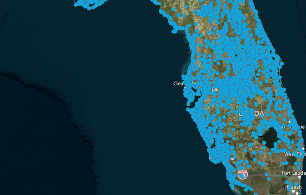
To protect vulnerable raptors this year, EagleWatch volunteers worked with local governments to safeguard nests in their communities while alerting the U.S. Fish and Wildlife Service to a potential new threat.
Based at the ‘º≈⁄ ”∆µ Center for Birds of Prey, EagleWatch monitors Bald Eagle nests in Florida, documenting nest status, location, and possible disturbances or threats to nesting activities. As one of the premier community science programs in Florida, EagleWatch works to protect approximately 40% of the state's nesting pairs. These efforts help ensure that we understand which areas are most critical to Bald Eagle population success, the threats those areas face, and how we can best safeguard the health and longevity of those habitats while respecting the needs of local communities.
Nearly brought to extinction by hunting in the late 1800s and later by the use of DDT in the 1950s, the Bald Eagle has made a comeback — after DDT was banned in the mid-1970s, Bald Eagle populations began to recover, and in 1995, the species was reclassified from “endangered” to “threatened” by the U.S. Fish and Wildlife Service. By 2007, Bald Eagles were removed from the list of Threatened and Endangered species, having sufficiently recovered.

Although they are no longer on the list of Threatened and Endangered species, Bald Eagles are still protected by both state and federal laws. Their current threats include habitat and nest destruction, vehicle strikes, and territory fights. With continuing land development, many eagles are choosing to nest on human-made structures such as power lines and communication towers. These non-natural nest sites can present unique hazards to the young eaglets when they fledge.
The EagleWatch program provides valuable information on nesting activity and current population trends of eagles in Florida. As a volunteer, you’ll monitor one or more eagle nests in your vicinity for the duration of the nesting season. These observations help biologists determine the best conservation measures to ensure the success of the species. Additionally, the reports may be used by law enforcement agencies to prevent any harm to the birds and their nesting sites.

The ‘º≈⁄ ”∆µ EagleWatch Program has around 750 dedicated volunteers currently monitoring more than 1,200 eagle nests in Florida. Today the program reaches many communities statewide, providing awareness of eagle nesting activities and conservation efforts for this iconic species.
We are looking for EagleWatch Volunteers!
Below are the main objectives of the EagleWatch program:
Compile data to help conserve critical Bald Eagle habitat in Florida.




Make a different for Bald Eagles in the Sunshine State.

To protect vulnerable raptors this year, EagleWatch volunteers worked with local governments to safeguard nests in their communities while alerting the U.S. Fish and Wildlife Service to a potential new threat.

Cheryl Merz was one of more than 130 people in line for public comment at the 11-hour county commission meeting last month.

EagleWatch celebrates 30 years of eagle conservation, a major milestone for the program and for Florida’s Bald Eagle population.

This season, staff banded and released eight eaglets from five counties. Six of the fledgling eagles came from natural nests and two came from nests on artificial structures. Since inception in 2017, the study has banded and released 48 juvenile eagles.

Bald Eagles in Osceola County are now nesting within half a mile of each other. In other areas of the state, they give each other a mile of space.

New Google map of nest locations incorporates data from the FWC’s plus new nests and relocations.
Let us send you the latest in bird and conservation news.